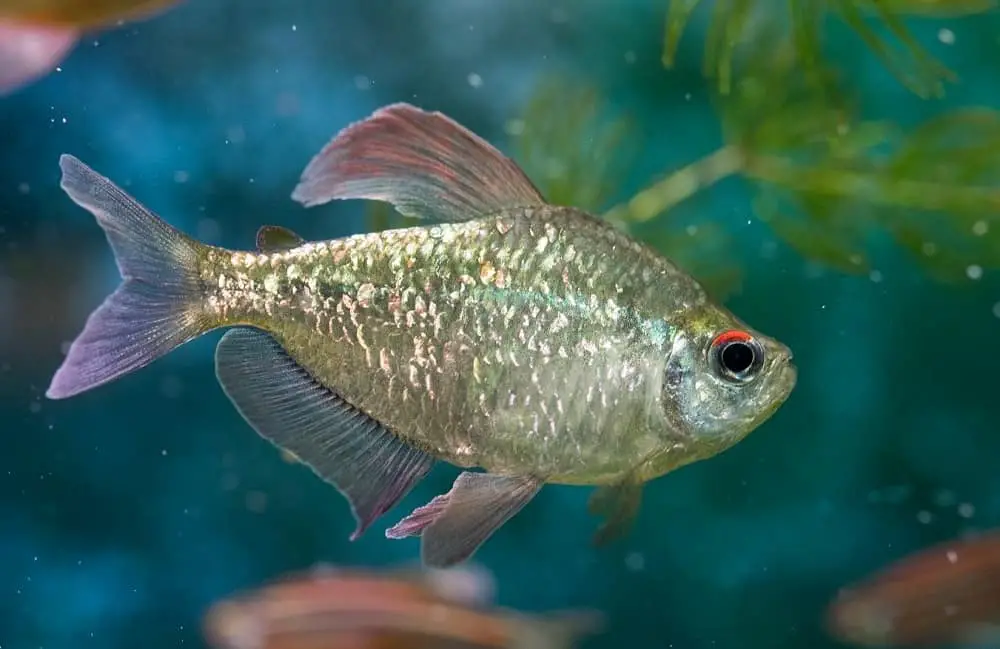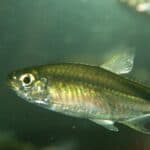The Diamond Tetra is a small freshwater species that belongs to the Characidae family. Its scientific name is Moenkhausia pittieri although it is sometimes called a timantti tetra.
In the wild, this fish is found inhabiting shallow, vegetated waters near the coastal area of Lake Valencia, South America. The Diamond Tetra can also be found in Aragua and Guacara rivers.

Diamond Tetras are a hardy species that are easy to care for and recommended for those who are new to owning fish.
Care Guide
Although Diamond Tetras are a low-maintenance species, they still have certain requirements and needs that must be met.
Tank Size
It is important to make sure that the tank is the correct size for your fish. Ideally, the tank should be at least 15 gallons. A tank of this size is going to be sufficient for a group of three Diamond Tetras.
If you intend to keep more, you should select a tank that has a 20 to 30 gallon capacity. They can be quite energetic so this ensures that they have plenty of space to swim freely. It is also easier to maintain the quality of the water in a larger tank.
Tank Mates
Whilst Diamond Tetras can be added to multispecies tanks you must think carefully about potential tank mates. Despite being known for their peaceful temperaments, Diamond Tetras are known as fin nippers. As they are schooling fish, Diamond Tetras need to be kept in a group for company.
When it comes to selecting appropriate tank mates, you must avoid choosing those that are aggressive as well as those that are a lot bigger than them. This is because larger fish are more likely to view them as food.
Diamond Tetras cope well when kept in a tank with guppies, corydoras, molly fish, and catfish.
Same Species Tanks
As we have mentioned, Diamond Tetras are schooling fish. They tend to feel more comfortable when kept in small groups with members of their own species. The recommended group number is between 6 and 8. If you do not intend to keep this many, you should make sure that there are at least 3 of them inside the tank.
When kept in a group amongst other species, they are more likely to fight with one another rather than harming the other species. If there are not enough Diamond Tetras inside the tank, you will likely find that the few that you do have are rather timid.
Water Parameters
You must make sure that you create the correct environment for your Diamond Tetras. In the wild, they are found in neutral, warm water. Although they can survive in alkaline water, they tend to thrive more when kept in slightly acidic water.
Ideally, the pH level should be between 5.5 and 7.5. Try to keep it just below neutral. Moreover, the recommended water temperature is between 75 and 82 degrees Fahrenheit to replicate the warmth of the waters that they are typically found in in South America.
A temperature within the range of 75 and 76 is preferred. In colder areas, you should use a heater to maintain the temperature of the water. As a species, Diamond Tetras are fairly tolerant when it comes to water hardness. The water should either be very soft or moderately hard. A pH within the range of 5 to 12 dH is sufficient.
It is recommended that you purchase a water testing kit. You can use this to maintain the correct water parameters and water quality. If needed, you can then make changes to the water.
What To Put In Their Tank
When setting up your Diamond Tetras tank you should try and replicate the conditions of the environment that they are naturally found in. In the wild, they live in vegetated streams and lakes. As such, you should make sure that your aquarium is equipped with a few plants. This is going to make them feel safe and will also provide them with somewhere to hide if needed.
The plants are also going to make the tank more shaded and this is going to be appreciated by the Diamond Tetras inside because they do not like being exposed to strong light. Add a combination of rooted and floating plants.
Begin by adding a layer of sand substrate to the base of the tank as this is going to enhance the natural feel. Then add your plants along with some driftwood, dried leaves, and twisting branches. You should also make sure that the tank is equipped with a filtration system that is going to maintain the quality of the water.
Common Diseases
Diseases do not tend to be a significant problem for Diamond Tetras. As they are a hardy species they tend to be able to endure quite a lot without suffering. Just like many other species they can be affected by diseases that can be avoided if they are provided with the correct care.
As a species in general, tetras are susceptible to bacterial and parasitic infections as well as ich. Conducting regular water checks will make sure that the water quality is right. Also, be cautious about what you add to the tank.
Food & Diet
As an omnivorous species, Diamond Tetras eat plants and small insects. Owners of Diamond Tetras do not have to worry about any fussy eating habits. When they are in the wild they will eat whatever they can forage but when kept in an aquarium they can eat flakes and pellets.
You should select a food that is nutritional and caters to their dietary needs. You can then supplement their day to day diet with frozen or live treats. It is also advised that you occasionally feed them some blanched vegetables as they are then going to be less likely to feast on the plants that you have inside the tank.
Lifespan
On average, Diamond Tetras are expected to live between 3 and 6 years when kept in an aquarium. There is no guarantee as to how long they are going to live for and it will largely depend on how well they are cared for.
Appearance
Diamond Tetras get their name from the silvery scales that cover its body. These scales have an iridescent shimmer with shades of gold, green, blue, and orange. As the fish ages, these colors are going to become more vibrant and noticeable.
Their eyes are rather unique with a small patch of red on the upper section of the iris.
Size
On average adult Diamond Tetras tend to be between 2 and 2.4” long. In comparison to other species, they are fairly small. They have rather long dorsal fins.
Behaviour & Temperament
Typically Diamond Tetras are not known as an aggressive species, though you might see them play fighting with their tank mates occasionally. They tend to prefer odd-numbered groups and can often be seen roaming the tank throughout the day in search of food.
Breeding
You must make sure that the fish that you are intending to mate are fed a high-quality diet. Breeding diamond tetras aren’t overly challenging, however, they do tend to be rather picky when it comes to finding a partner. This is because they will only mate with other fish that are the same age and size as them. If possible, you should try and put the breeders in a separate tank for around 6 to 8 days before spawning is expected to occur.
Also, make sure that the lights in the tank are dimmed. The female will lay the eggs and the male will then fertilize them. Once the eggs have been laid, you should separate them from the parents because there is a risk that they will be eaten. Usually, the eggs will hatch 36 hours after they have been laid and the fry will then be swimming 4 days after they have been laid.
Gender Differences: Male vs Female
Female Diamond Tetras are usually smaller than males. In terms of appearance, they tend to have fewer scales and their bodies are not as brightly colored. Moreover, females have a short dorsal fine whilst males have fins that are longer and pointier.
Fun Facts
- Diamond Tetras are slightly larger than other tetras. However, they still have the same compressed lateral bodies.
- They are rather active fish that tend to swim in the middle and bottom sections of the tank.
- When young Diamond Tetras reach the age of 6 to 7 months they develop all of the features that the adults have and from this point, they are also ready to breed.
- Diamond Tetras can be bred in single pairs or groups as large as 12.
- These fish are keen eaters that will eat just about anything that they are offered, however, it is still important to make sure that you are giving them foods that contribute to a healthy diet.
- The appearance of female Diamond Tetras will change slightly once they reach the point when they are ready to reproduce.








